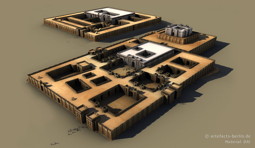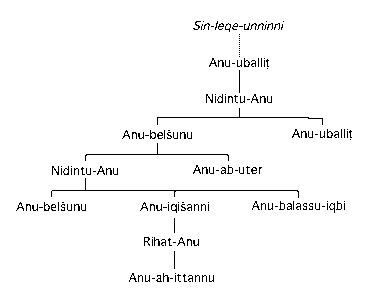The Rēš temple, Uruk
The Rēš temple

A reconstruction of the Rēš temple in Uruk and its surroundings, (c) Artefacts Berlin. View image on Artefacts Berlin's website.
Bīt Rēš or Rēš was the temple of the god Anu during the Late Babylonian period, at least from the middle of the 5th century B.C. Two difficulties are encountered in this area. The first one is that the buildings were largely eroded so that substantial parts disappeared. The second problem is illegal excavations, which were frequent from the 19th century and especially at the beginning of the 20th and which badly damaged the temple architecture. These facts explain the bad condition of most of the buildings and tablets.
The tablets found by illegal diggers were sold to many museums and private collections. Consequently, it appears that many tablets discovered that way came from the Rēš temple and the kalûs' library, which was later unearthed by the German archaeologists. Indeed, there are some physical joins between the tablets found during illegal excavations and the German work. For example, ACT 100 results from a join between TCL 6, 22 (without archaeological context) and U 126 (from the excavations of 1912-1913). However, the finest and clearest discoveries were made by German archaeologists during the 18th excavation season, in 1959-1960.

The Sin-leqe-unninni family of the Rēš temple, Uruk.
Discovery of the kalûs' library
In locus Le XVI3, inside the Rēš temple, a library was found, still in situ, but the tablets were in very bad condition, almost all broken and scattered on the floor. Only eight were discovered on shelves but their arrangement was not registered. The library was situated in the south-east part of the Rēš temple, immediately north of the southeast gate of the temple precinct. It is difficult to recover the limits of the room because it is very poorly preserved. The chamber was paved with small bricks and had previously been used as an additional gate before being closed from the outside and rebuilt as a room. Almost all the tablets unearthed here, including the contracts and administrative texts, had a close link to the Sin-leqe-unninni family. In this specific corpus, the most representative scholar was Anu-belšunu, son of Nidintu-Anu. Actually, the kalû-priests of the Rēš had all been from the Sīn-leqe-unninni family since the Achaemenid period, so what could be seen as a private library inside the temple is, in fact, the library of the temple kalû-priests. The specialisation in the genres of kalûtu is the main reason for understanding this as a professional library, whereas in the āšipus' house(s) literary and erudite tablets from all scholarly genres were found.
The kalûs' library may have been a very specific area reserved for the kalû-priests. The problem is to link it with the temple library itself. It seems that many tablets found by illegal diggers were found in this part of the building, especially the mathematical astronomical texts published in ACT. In this corpus the Sin-leqe-unninni family also appears side by side with the āšipus from the Ekur-zakir family. There are also other kinds of scholarly tablets from illegal excavations . So, a part of the Rēš temple's main library was certainly unearthed by illegal diggers at the beginning of the 20th century.
The tablets today
The archaeologists unearthed 141 tablets and fragments including 21 contracts, 6 administrative texts, 2 letters and 112 scholarly texts. They are all published in BagM Beih. 2 (below) and are kept in the National Museum of Iraq, Baghdad.
Bibliography
- van Dijk and Mayer, BagM Beih. 2, 1980.
Philippe Clancier
Philippe Clancier, 'The Rēš temple, Uruk', The Geography of Knowledge, The GKAB Project, 2019 [http://oracc.museum.upenn.edu/cams/gkab/contexts/reshtemple/]